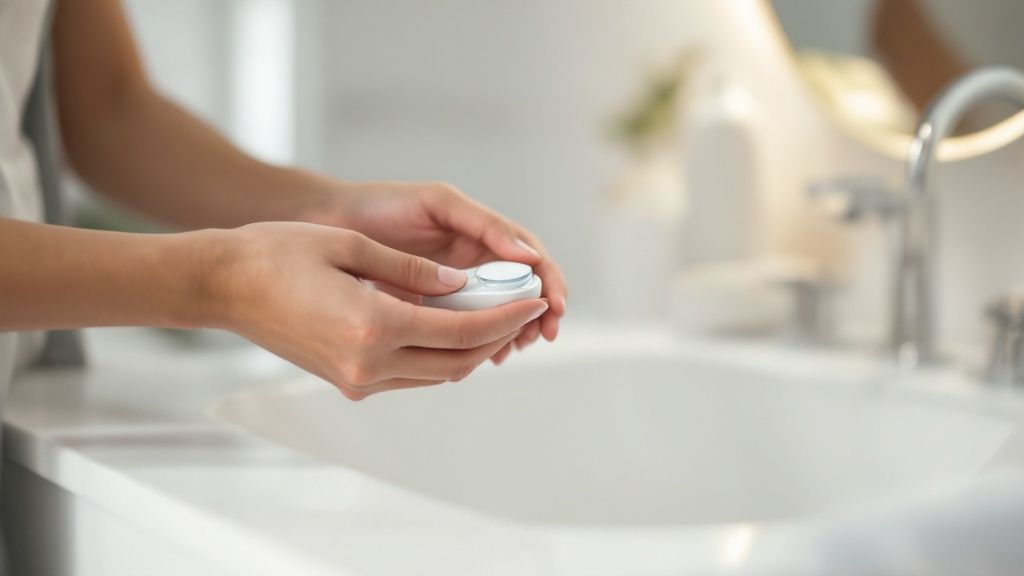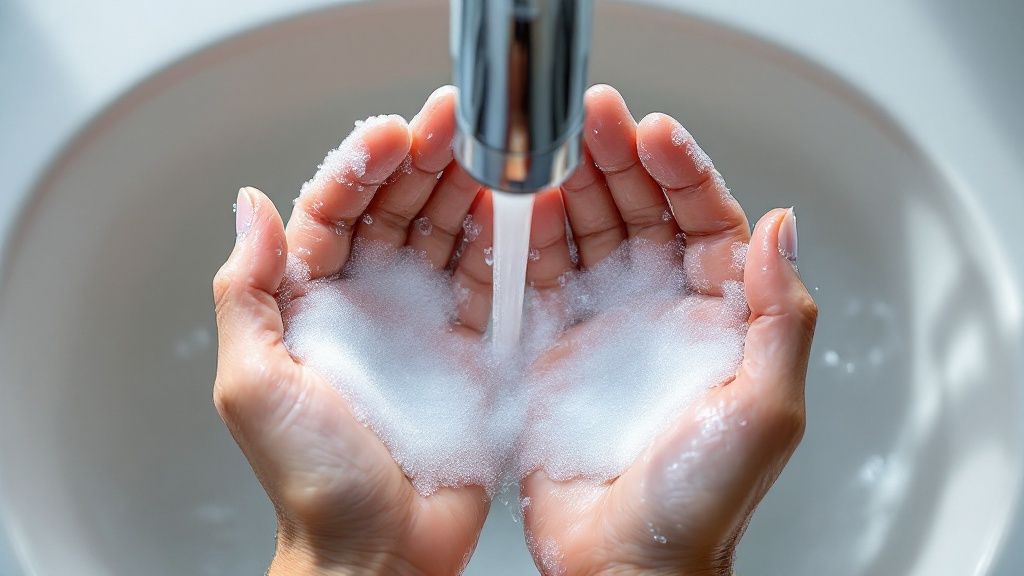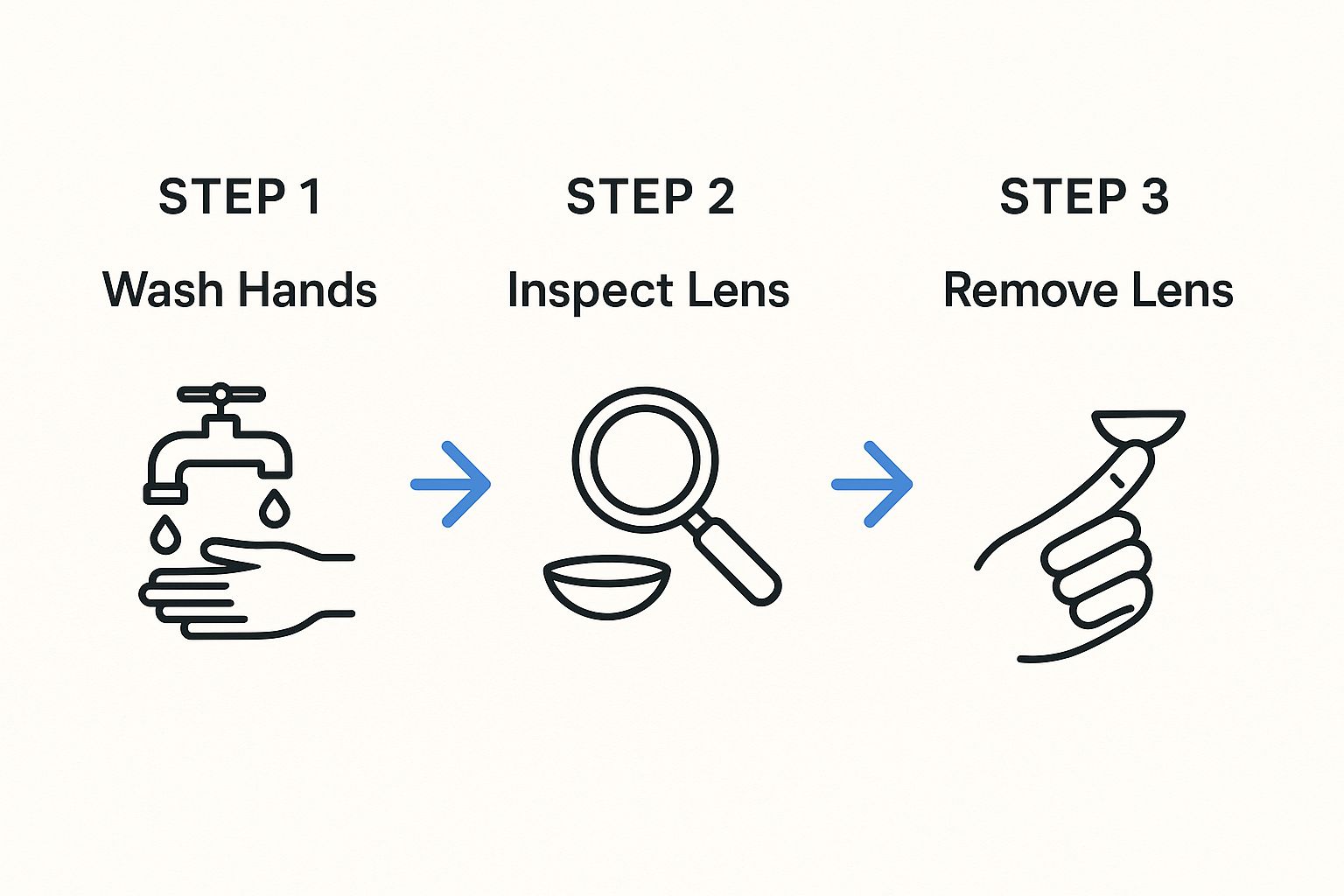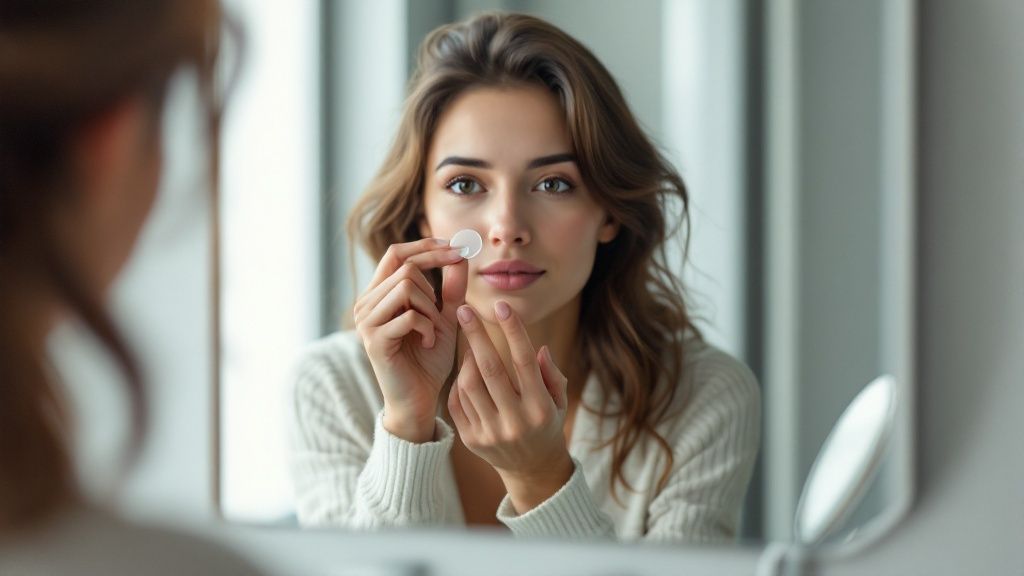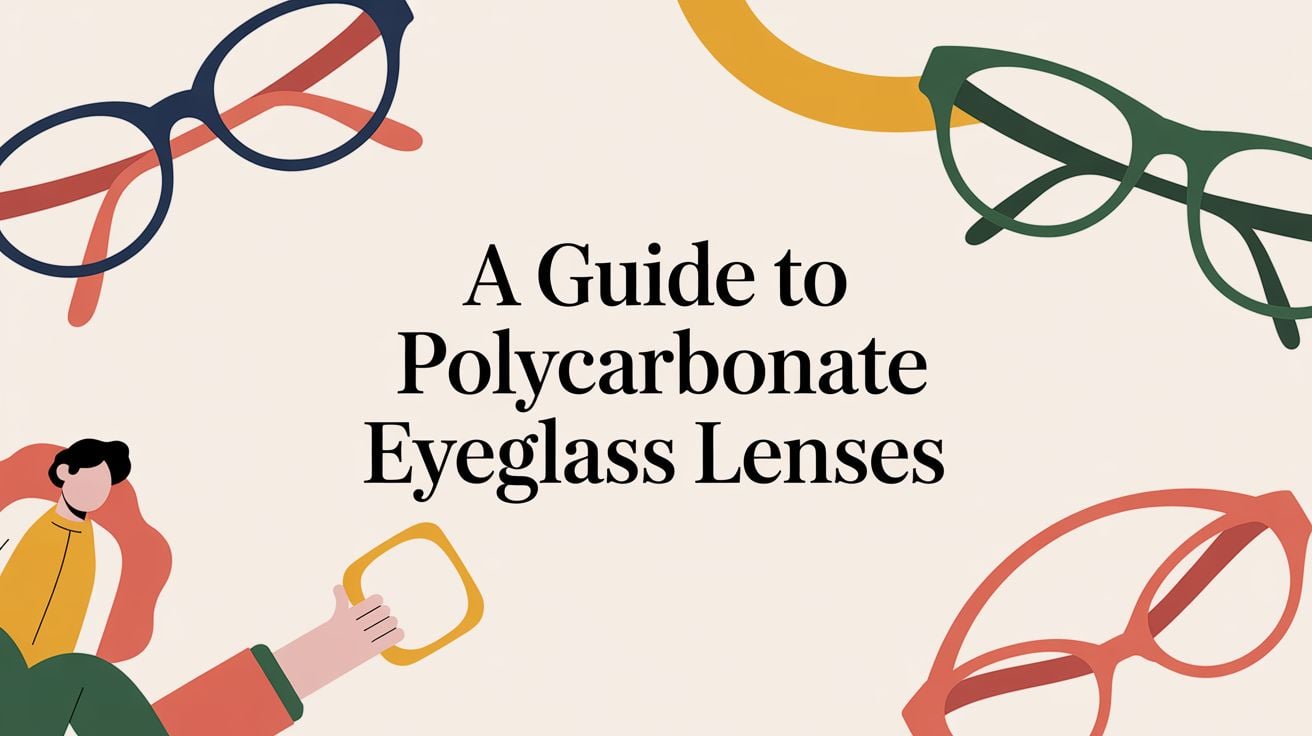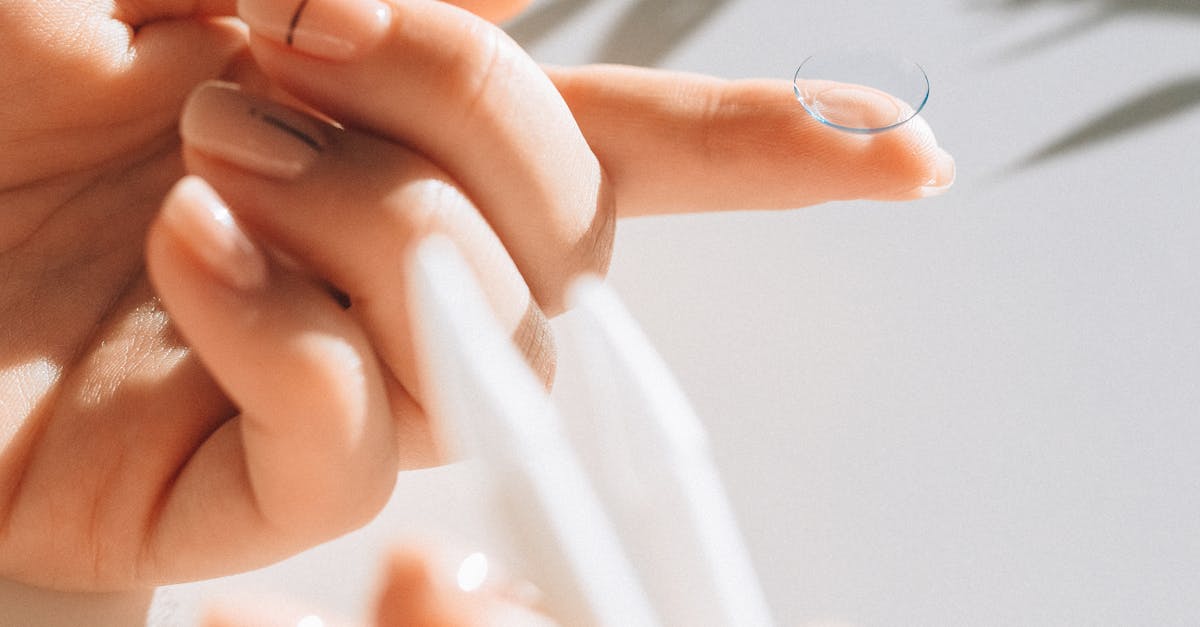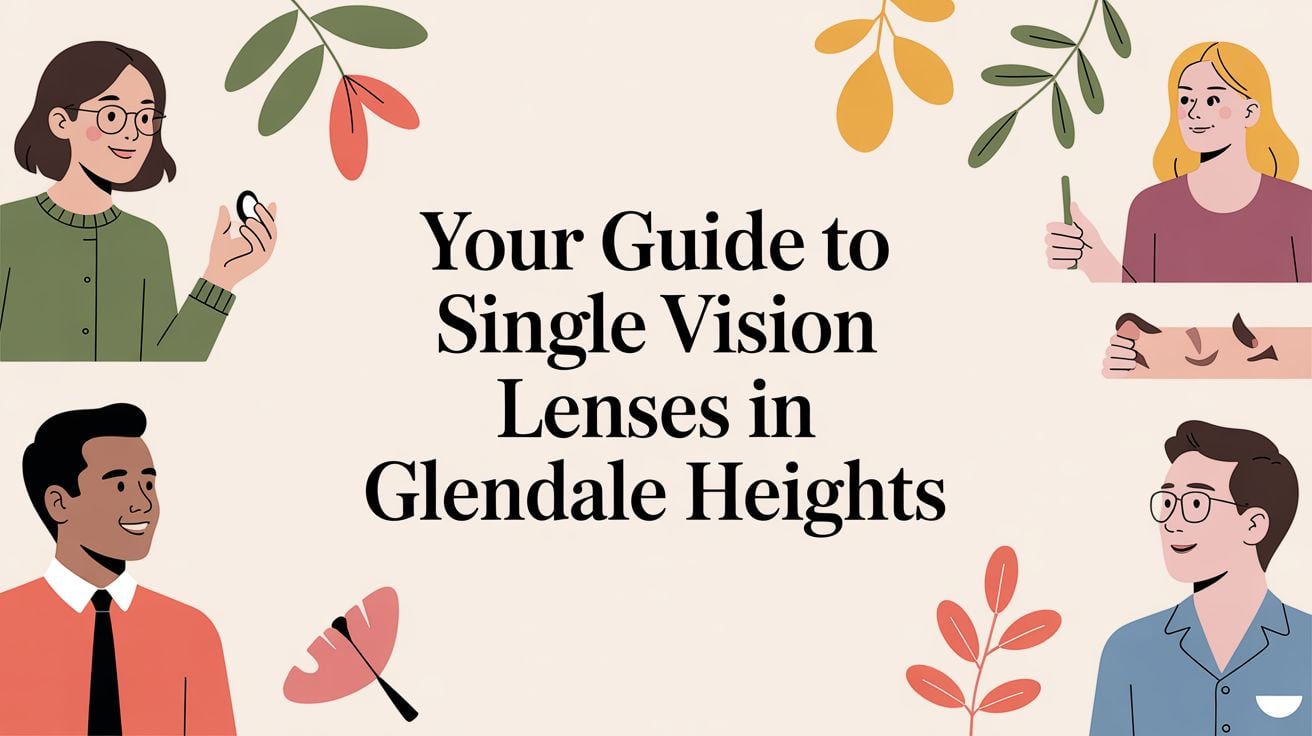Taking your contacts out at the end of the day should be a relief, not a chore. The whole process really boils down to two things: keeping your hands squeaky clean and mastering a gentle "pinch" technique. For our patients here at iDoctor in Glendale Heights, getting this right is the key to a comfortable, hassle-free experience.
A Better Way to Take Out Your Contact Lenses
Whether you’re a new wearer feeling a bit clumsy after a long day at Glenbard West High School or a seasoned pro just looking for a better way, mastering contact lens removal is essential. This guide is about building the confidence to handle your lenses safely and without irritation, time after time.
Here at iDoctor, your trusted optometrist in Glendale Heights, we want to make sure you feel in control of your daily eye care, whether you're winding down after a round at the Glendale Lakes Golf Club or just getting home from your commute on North Avenue.
Why Your Removal Routine Matters So Much
A solid routine is about more than just getting the lens out of your eye. It's the foundation for healthy, comfortable wear for years to come. In our experience as eye care professionals, most problems people have with contacts stem from improper handling.
A great removal routine helps you sidestep common issues like:
- Annoying Irritation: A gentle touch is key to keeping your eyes from getting red and sore.
- Corneal Scratches: This is a big one. Always use the soft pads of your fingers, never your nails, to avoid scratching your eye.
- Nasty Infections: Clean hands are your number one defense against bacteria that can cause serious infections.
You'd be surprised how many people stop wearing contacts simply because they struggle to get them in and out. That’s why we focus so much on hands-on training and practice during our fittings. It truly is the single best way to set you up for success.
Our team is here to provide that personal training for anyone getting new prescription contact lenses. We believe that with the right guidance, anyone can master this simple but crucial skill, making their contact lens experience a great one.
Setting the Stage for a Flawless Removal
The secret to taking your contacts out without a fuss? It all starts before you even touch your eye. Think of it like a pilot's pre-flight checklist—a simple, repeatable routine is the best way to make the process safe, clean, and comfortable every time.
This prep work is your first line of defense against things nobody wants, like a scratched cornea or a painful eye infection. Taking a few moments to get everything right can save you a world of trouble later on.
Start with Impeccable Hygiene
Your hands introduce just about everything to your eyes, so this is the most important step. Always, always start by washing your hands thoroughly. Use a simple, lotion-free soap and warm water, and scrub for at least 20 seconds.
Once they're clean, dry them completely with a lint-free towel. Why lint-free? Because those tiny, fuzzy fibers from a regular towel can easily get on your fingertips, slip under your lens, and cause instant irritation.
Create Your Removal Environment
Find a clean, well-lit spot, preferably in front of a mirror. Good lighting is your best friend here, especially if you're new to contacts. It helps you see exactly what you're doing and builds confidence.
Here’s a pro tip: always keep rewetting drops handy. If your eyes feel dry after a long day (which is completely normal!), a couple of drops will work wonders. A lubricated lens moves freely and is much easier to remove than a dry one that feels stuck to your eye.
Making sure you have the prep work down is a huge part of what we teach during a professional contact lens fitting. We walk you through every step to ensure you leave our boutique feeling like a pro.
Your Pre-Removal Safety Checklist
Before you begin, run through this quick mental checklist. It only takes a minute but makes a huge difference in keeping your eyes safe and comfortable.
| Action | The Reason It Matters | Pro-Tip from Our Optometrists |
|---|---|---|
| Wash Hands Thoroughly | This is your #1 defense against transferring harmful bacteria directly to your eye, which can cause serious infections. | Sing "Happy Birthday" twice while scrubbing. It’s the perfect timer to ensure you’ve washed long enough! |
| Dry with a Lint-Free Towel | Prevents tiny, irritating fibers from getting on your fingers and trapped under the contact lens. | Microfiber cloths or even high-quality paper towels work great in a pinch if you don't have a lint-free towel. |
| Find a Well-Lit Area | Good lighting helps you see the lens clearly, reducing fumbling and minimizing the risk of accidentally poking your eye. | A bathroom vanity with bright, overhead lighting is ideal. Avoid dim, shadowy rooms. |
| Have Rewetting Drops Ready | A dry lens can stick to your eye, making removal uncomfortable. Drops lubricate the lens so it slides out easily. | If your eyes feel even slightly dry, use a drop or two before you attempt removal. Don't wait until you're struggling. |
This simple routine is the foundation for healthy, happy contact lens wear. Once it becomes a habit, you won't even have to think about it.
Mastering the Gentle Pinch Removal Method
Alright, let's get hands-on. The "gentle pinch" is the most common and effective technique for taking out soft contact lenses. With a little practice, it will feel as natural as blinking. This is all about controlled, gentle movements—never force.
First, you need to manage your automatic blink reflex. We all have it. Use your non-dominant hand to gently hold your upper eyelid up against your brow bone. This keeps your lashes out of the way and gives you a stable, clear field to work with.
Next, take the middle finger of your dominant hand and gently pull your lower eyelid down. This opens up the eye, giving you easy access to the lens.
The Gentle Pinch Explained
Now for the main event. Look straight into the mirror, or even slightly upward. Bring the soft pads of your index finger and thumb toward your eye.
The idea is to place them on either side of the contact lens and apply just enough pressure to lightly pinch the edges together. This action makes the lens buckle slightly, breaking the suction and lifting it right off the surface of your eye.
The secret is a confident but gentle touch. We always tell our patients to imagine they're picking up something incredibly delicate, like a flower petal. You need to be firm enough to get a grip, but gentle enough that you don't damage it. That mindset is key to avoiding any accidental pokes or irritation.
This infographic breaks down the core actions into a simple, visual guide.
As you can see, successful removal comes down to a simple, three-part process that starts with good hygiene and ends with the right technique.
What happens if the lens folds or slips? Don't panic. It happens to everyone. Just release your eyelids, blink a few times to let the lens recenter itself, and then give it another try. If your eyes feel dry or the lens seems stuck, a drop of rewetting solution can work wonders.
The more you do this, the more it becomes muscle memory. Once you've got removal down, you can check out our guide on how to insert contact lenses to become a pro at the full routine. With a bit of patience, you'll be taking your lenses out in seconds, completely stress-free.
What to Do When Contact Lens Removal Goes Wrong
Even when you've got the process down, you might hit a snag every now and then. Don't worry—it happens to the best of us. The number one issue people face is a lens that feels completely "stuck" to their eye. It’s an alarming feeling, but in almost every case, a stuck lens is simply a dry lens. Trying to force it out will just lead to a red, irritated eye. The real solution is all about rehydration.
Dealing With a Stubborn Lens
When a lens refuses to budge, your first instinct might be to pinch harder. Resist that urge! A gentle approach is always better.
Instead, here’s what you should do:
- Add Moisture: Grab some sterile saline solution or contact lens rewetting drops. Apply several drops directly into your eye to rehydrate the lens.
- Blink and Massage: Close your eye and blink a few times. Then, using your fingertip, very gently massage your eyelid. This helps the moisture work its way underneath the lens.
- Wait a Minute: Be patient. Give it at least 30 seconds for the lens to fully rehydrate and loosen its grip. Then, you can try the pinch method again.
This simple routine almost always does the trick. Sometimes, the lens isn't stuck but just slick from protein buildup, making it hard to grip. You can learn more about managing contact lens protein deposits in our detailed guide.
Frustration during removal is a huge reason people give up on contacts. But with a little knowledge and patience, these common hurdles are easy to clear. It’s all about having the right troubleshooting tricks up your sleeve.
Repositioning a Folded or Off-Center Lens
Every once in a while, a lens will fold over on itself or slide off-center. Again, the key is not to panic.
Just close your eye and look in the opposite direction of where the lens feels like it's gone. For instance, if you feel it high up under your eyelid, look down toward your chin. This simple movement often encourages the lens to slide right back into place on your cornea. A few gentle blinks will usually help it re-center completely.
Discomfort during removal is a serious issue; it affects about one in six wearers. The good news? Proper education can make all the difference. Mastering these simple skills is absolutely essential for a happy, long-term relationship with your lenses.
What to Do After Your Lenses Are Out
You’ve got your lenses out. Great! But your job isn’t done yet. What comes next is just as crucial for keeping your eyes healthy and your lenses comfortable for the next time you wear them.
If you use daily disposables, your next step is the easiest one: throw them away immediately. Dailies aren't built for cleaning and reusing them is just asking for trouble—they can become a breeding ground for bacteria that can lead to serious eye infections.
Caring for Reusable Lenses
For those with bi-weekly or monthly lenses, the routine takes a couple more minutes, but it’s time well spent. The gold standard is the "rub and rinse" method.
Don't just pop your lenses into the case. Place one lens in the palm of your clean hand, add a few drops of your recommended contact lens solution, and gently rub it with your fingertip for about 20 seconds. This friction physically breaks up the gunk like protein and lipids that builds up during the day.
Once you’re done rubbing, give the lens a thorough rinse with more fresh solution before placing it in a clean case. If you want to master the technique, check out our complete guide on the best way to clean contacts.
One of the worst habits we see is "topping off" the solution in the case. Never do this. It’s like trying to wash your hands in dirty water. Always dump the old solution, rinse the case with fresh solution, and fill it with new solution. Every single day.
Don't Forget Your Lens Case
That little plastic case needs daily TLC, too. After you put your lenses in, rinse the empty case with sterile solution—never tap water!—and leave it uncapped and upside down on a clean tissue to air-dry completely. This step helps prevent biofilm, a slimy layer of bacteria, from forming.
You should also replace your case every one to three months, no exceptions. It’s a cheap and easy way to avoid a nasty infection.
After your lenses are out for the day, give your eyes a break. You might even consider some stylish frames or explore the latest trends in protective eyewear. Whether you prefer daily disposables or reusables, following these post-removal habits is vital for eye health.
FAQ: Your Local Contact Lens Questions
Whether you're a student at Glenbard East High School trying contacts for the first time or a long-time wearer from anywhere in DuPage County, certain questions always pop up. Here are straightforward answers from your local Glendale Heights eye doctor.
Where can I get designer eyeglasses in Glendale Heights?
Right here at iDoctor! In addition to expert contact lens care, we offer a curated collection of luxury eyewear from brands like Cartier, Gucci, and Tom Ford, as well as affordable styles from Ray-Ban and Coach. Whether you need a backup pair or just want to switch up your look, we have something for everyone.
Where can I get a professional contact lens fitting in Glendale Heights?
At iDoctor, a proper fitting is more than just a prescription. We take the time to make sure your lenses are a perfect match for your eye shape and lifestyle. More importantly, we provide hands-on training for inserting and removing them, so you leave our boutique feeling completely confident.
What if my eye is red or painful after removing my lens?
First, don't put the lens back in. If you're seeing redness or feeling any pain, light sensitivity, or have blurry vision after taking out a lens, that’s your eye telling you something is wrong. Call your eye doctor in Glendale Heights immediately. We treat these symptoms as urgent because they could be a sign of a scratch or infection that needs prompt attention.
Can I use tap water to rinse my lenses or case?
Never. This is a hard-and-fast rule. Tap water contains microorganisms that can cause serious, even sight-threatening, eye infections. Always use fresh, sterile contact lens solution for all rinsing and storing. It's one of the most critical habits for safe lens wear.
For any other questions or to book your detailed eye exam in Glendale Heights, the iDoctor team is always here to help you see clearly and comfortably from our boutique right here in Glendale Heights.


